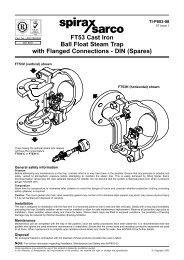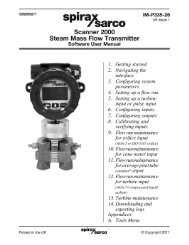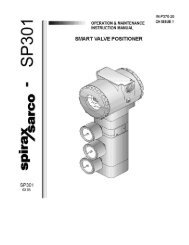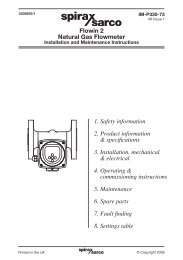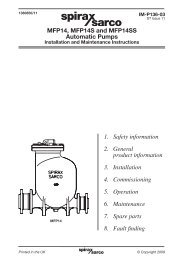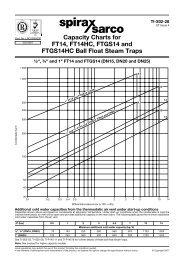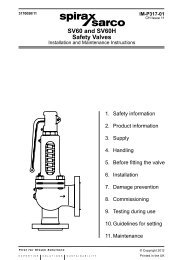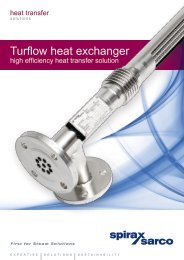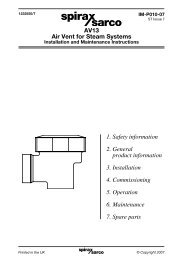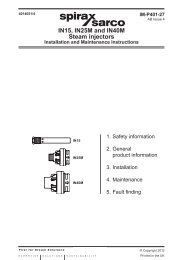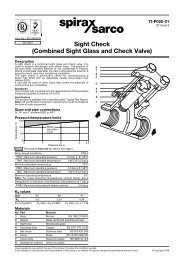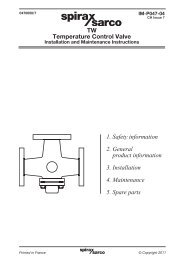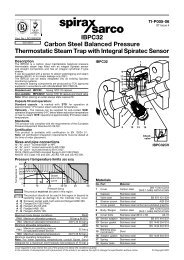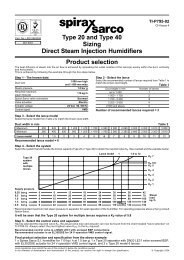Scanner 2000 Steam Mass Flow Transmitter ... - Spirax Sarco
Scanner 2000 Steam Mass Flow Transmitter ... - Spirax Sarco
Scanner 2000 Steam Mass Flow Transmitter ... - Spirax Sarco
You also want an ePaper? Increase the reach of your titles
YUMPU automatically turns print PDFs into web optimized ePapers that Google loves.
<strong>Scanner</strong> ® <strong>2000</strong> microEFM Section 2<br />
Measuring <strong>Steam</strong> via a Differential Pressure Meter<br />
Note This section contains installation guidelines for orifice and cone meters. If installing the <strong>Scanner</strong> <strong>2000</strong><br />
with an averaging pitot tube meter, refer to manufacturer instructions for installation.<br />
Best Practices<br />
The <strong>Scanner</strong> <strong>2000</strong> microEFM calculates steam flow in accordance with IF-97, AGA-3, and ISO-5167 industry<br />
standards. For optimum performance, ensure that the <strong>Scanner</strong> <strong>2000</strong> installation complies with the industry<br />
recommendations listed below:<br />
Condensate pots<br />
• A condensate pot for a small-volume transducer like the <strong>Scanner</strong> <strong>2000</strong> MVT can be a simple pipe tee,<br />
oriented so that one port extends downward (into the cold leg), the opposite port extends upward and is<br />
closed by a pipe cap or blowdown valve, and the tee extends horizontally into the hot leg.<br />
• The pots should be the highest point in the system.<br />
• The pots should be mounted at the same level, and one or both should be adjustable vertically to remove<br />
zero shifts in the differential pressure measurement.<br />
Hot legs<br />
• Hot legs should be large diameter (3/8 in. or 1/2 in., if possible)<br />
• Hot legs should be as short as possible. If these sections must be more than 1 ft. in length, insulate them.<br />
• Elbows and bends should not form any traps in which liquid can accumulate.<br />
• Hot legs should be sloped along their entire length to allow liquids to drain back into the pipe.<br />
Cold legs<br />
• Cold legs should enter the multi-variable sensor through its side ports.<br />
• Cold legs should be a minimum of 2 ft in length to allow proper convection cooling and should be run<br />
horizontally with a slope of approximately 1 inch per foot to allow air bubbles to float up into the pots.<br />
• Elbows and bends should not form any traps for air bubbles.<br />
• Cold legs should be filled with a suitable antifreeze. Dibutyl phthalate is recommended.<br />
Antifreeze<br />
• Dibutyl phthalate (DBP) has the following advantages over glycol antifreeze:<br />
– DBP doesn’t mix with water, and so doesn’t become dilute over time; its specific gravity doesn’t shift.<br />
– It is slightly denser than water, so it will stay in the pot permanently.<br />
– It is non-flammable.<br />
– It is much less toxic than glycol.<br />
– It is available from industrial suppliers.<br />
Valves<br />
• Use only full-opening block valves that are rated for steam service.<br />
• Use only blowdown valves that are rated for steam service. Periodic blowdowns are recommended for<br />
preventing buildup of scale.<br />
39



